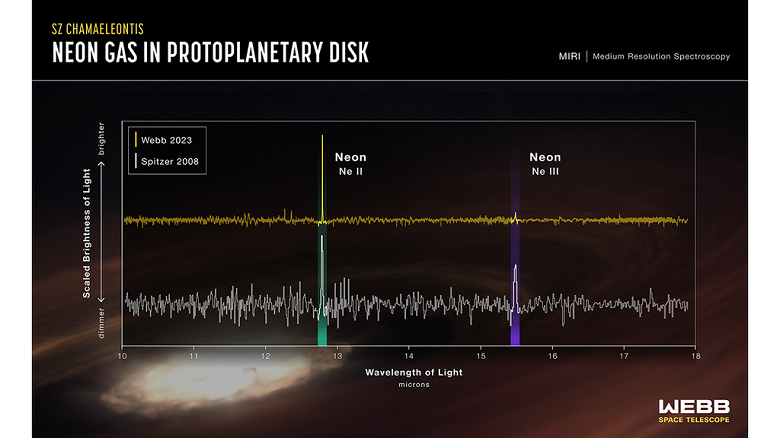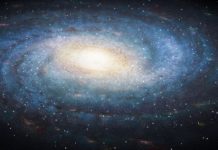The James Webb Telescope helped observe the disappearance of the disk around the young star SZ Cha
Data obtained with the James Webb Space Telescope (JWST) allowed us to draw conclusions about the process of planet formation in gas-dust disks. It turns out that the amount of ionized neon in these disks can serve as an indicator of the rate of planet formation.
Previously, astronomers have already observed disks of gas and dust around young stars, but the process of their formation takes a very long time – hundreds of thousands, or even millions of years. It is almost impossible to observe changes in disks over short time intervals. In a new study, James Webb was able to detect changes in one of these disks where planet formation occurs.
In observations made by a team led by Catherine Espaillat in 2008 using NASA’s Spitzer Telescope, an infrared spectral line associated with doubly ionized neon ([Ne III]) was seen. The signal came from a disk of gas and dust around the young star SZ Chamaeleontis (SZ Cha).

James Webb Helps Find Key to the Rate of Planet Formation
When an atom collides with a photon, it becomes “ionized” and “doubly ionized” atoms lose two electrons. In the SZ Cha disk, the amount of doubly ionized neon appears to be very low compared to disks typically exposed to X-ray emission from young stars. The appearance of this neon indicated that the dominant type of radiation in the SZ Cha system was “extreme ultraviolet” (EUV) radiation, capable of destroying gas and dust in the protoplanetary disk, but not as quickly as X-rays. X-ray radiation destroys the protoplanetary disk 100 times faster than ultraviolet radiation.
From this we can conclude that the rate of “evaporation” of the disk and, accordingly, the time during which the formation of planets is possible depends on the energy and type of radiation.
In 2023, Espaillat and her team conducted a new long-term observation of the SZ Cha system using JWST’s MIRI instrument. The scientists found that the amount of doubly ionized neon was significantly reduced compared to singly ionized neon. Additional observations using ground-based telescopes allow us to study the properties of protoplanetary disks in even more detail. For example, the CHIRON spectrometer on the SMARTS telescope at Cerro Tololo Observatory measured the blueshift of alpha hydrogen from the star SZ Cha. The blue shift is a Doppler-type change that indicates that something is moving toward our detectors, in this case hydrogen.
Scientists interpret this phenomenon as a “stellar wind” of particles emanating from the star. This wind is thought to be dense enough to absorb ultraviolet radiation, but still transmits X-rays, indicating the latter’s dominance in the evolution of this star system.
The discovery of doubly ionized neon in 2008, but its absence in subsequent observations, supports the assumption of X-ray dominance in the SZ Cha system.
Thus, the amount of doubly ionized neon can serve as an indicator of ultraviolet and X-ray radiation affecting the protoplanetary disk. Astronomers can use this value to more accurately determine the time it takes planets to form in such a system before their disk disappears.




